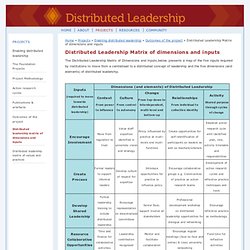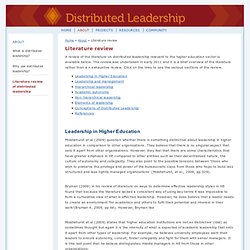

Distributed Leadership Matrix of dimensions and inputs. The Distributed Leadership Matrix of Dimensions and Inputs,below, presents a map of the five inputs required by institutions to move from a centralised to a distributed concept of leadership and the five dimensions (and elements) of distributed leadership.

The five inputs needed to move towards a distributed leadership approach were identified as: encouragement for involvement; creation of processes; development of shared leadership; provision of resources to aid collaborative opportunities and support for engagement. Each column of Distributed Leadership Matrix of Dimensions and Inputs identifies the elements that make up a particular dimension. For example, the elements for the dimension of Context is found in the range from power to influence.
The Distributed Leadership Matrix of Dimensions and Inputs provides institutions with the opportunity to map what inputs are needed to achieve the dimensions needed for distributed leadership. ALTC: Distributed Leadership. A review of the literature on distributed leadership relevant to the higher education sector is available below.

The review was undertaken in early 2011 and it is a brief overview of the literature rather than a n exhaustive review. Click on the links to see the various sections of the review. Middlehurst et al (2009) question whether there is something distinctive about leadership in higher education in comparison to other organisations. They believe that there is no singular aspect that sets it apart from other organisations. However, they feel that there are some characteristics that have greater emphasis in HE compared to other entities such as their decentralised nature, the culture of autonomy and collegiality. Bryman (2009) in his review of literature on ways to determine effective leadership styles in HE found that because the literature lacked a consistent way of using key terms it was impossible to form a cumulative view of what is effective leadership. References Pounder, J. Www.google.com.au/url?sa=t&rct=j&q=democratic leadership style in schools&source=web&cd=10&cad=rja&ved=0CHUQFjAJ&url=http%3A%2F%2Fccsenet.org%2Fjournal%2Findex.php%2Fibr%2Farticle%2Fdownload%2F14599%2F12891&ei=9CkMU-CgHMuglQWs6IGIBQ&usg=AFQjCNGfMFZy4leDEx.
Dtl.unimelb.edu.au//exlibris/dtl/d3_1/apache_media/L2V4bGlicmlzL2R0bC9kM18xL2FwYWNoZV9tZWRpYS83NDY4OA==.pdf. The problem of distributed leadership in schools - School Leadership & Management - Volume 24, Issue 3. Teacher Leadership as Distributed Leadership: Heresy, fantasy or possibility? - School Leadership & Management - Volume 23, Issue 3. Degrees of distribution: towards an understanding of variations in the nature of distributed leadership in schools - School Leadership & Management - Volume 27, Issue 4. Www.distributedleadership.org/DLS/Publications_files/PUBLISHED Harris, Spillane. Distributed Leadership through the Looking Glass.pdf. Reimagining School:When Teachers Run the School. Today, it has become nearly impossible for a single individual to properly administer and lead a school. School leaders must assume responsibilities in an ever-wider range of areas: instruction, school culture, management, strategic development, micropolitics, human resources, and external development (Portin, 2004).
Any one principal will have difficulty successfully managing all these areas on his or her own. One alternative approach to school governance has great potential for success—the democratic and distributed leadership model. This model secures staff members' full participation in the school's decision-making processes, promotes meaningful collaboration and harmonious work relations, generates passion for accomplishing goals, and boosts student and teacher productivity.
Beyond Distributed Leadership does not necessarily imply that the entire faculty controls decisions related to the school. Two Defining Characteristics Minimal Structural and Functional Differentiation References. Www.almaharris.co.uk/files/distributed_leadership_pamphlet.pdf.